#informational resource
Explore tagged Tumblr posts
Text
How free are you? A Poll
Instructions: If the answer to the question is 'yes', give yourself 1 point. If the answer is 'no', take 1 point away. If the answer is 'maybe', or 'I don't know', or 'unsure', don't add any points.
Can you wear whatever you want, without having to explain yourself or worry about getting berated for it?
Can you choose what to do with your own time, without having anyone criticize or guilt you for it?
Can you choose what you eat every day, or at least reject the food you don't want to eat?
Do you have access to food that is nourishing, healthy and unlikely to cause any health issues in the long term?
Can you choose freely who you spend your time with, without reprecussions?
Can you choose what you do for a job? Can you change it without severe consequences for your financial stability?
Are you allowed to go wherever you please, if your finances allow for it?
Do you have a community of people you're connected to, who have the same or similar beliefs and circumstances as you do?
Do you have a network (or a family) of people who you consider to be 'your people', who accept you and care about you?
Will you be okay and taken care of in case of illness, injury, incident or a disaster?
Can you choose your own religion, or reject a religion, without severe social consequences?
Do you have knowledge of your basic human rights, and are you informed on what to do if some of these rights get violated?
Can you go about life without ever worrying about physical violence occuring from a person you know and are around?
Can you go about life without worrying about physical violence coming from a stranger?
Can you walk the planet without being self-conscious of your body and how you're perceived, and being objectified or devalued because of it?
Do you feel safe and comfortable in most of the places you exist in?
Can you get by without taking special measures, such as hiding, lying, escaping, locking yourself in, avoiding certain places and activities, avoiding certain people, changing your name, in order to be safe in the world?
Do you have safe access to communication with people you want to communicate with?
Can you access the money you need without having to ask or explain why you need it?
Do you feel safe that your basic physical needs, such as food, clothing, sanitary items, tools, shelter and utilities are and will stay accessible to you?
Do you have secure access to healthcare, without having to severely worry about the financial aspect of it, or about someone barring you from access?
Do you have reliable information about your own health, and about how the activities you do might affect it, both for better and for worse?
Are you allowed to change your mind about how you feel about the issues in the world, your own circumstances, people around you, your faith and your politics, without being outcasted from your group of peers?
Can you go trough life without worrying about a hate crime being committed against you, both by people you know and strangers?
Is your health and physical state of body stable enough to work a full time job?
Can you secure enough money to live comfortably, without your physical or psychological health suffering and deteriorating for it?
Can you comfortably communicate your needs, feelings, problems, struggles and affection to others, when you want to?
Can you speak your mind most of the time, without worrying about reprecussions?
Can you be open about your interests, hobbies, beliefs, sexuality, identity, politics and relationships with most of the people around you?
Can you comfortably speak about the circumstances and facts of your life, without being corrected or denied to name some of them?
Can you recognize when a choice has been taken away from you, and things have been decided for you? If yes, can you also walk away from this, and refuse to take on the consequences?
Can you comfortably place blame on the people who have caused you distress and pain in your life, without any pushback or criticism for doing so?
Do you have support, knowledge and resources you need in order to deal with grief and tragedy?
Can you feel comfortable and at ease around all people you are around with?
Can you freely confront a person in your life who has attempted to cause injustice to you, even if that person is in position of authority to you? Do you feel safe and able to do so?
Can you freely choose your sexual partner(s), or refuse any you don't want without having to worry about their feelings, assault, your financial situation or your safety?
Can you choose freely to undo any consequences sex had on your body, if you don't want it to be happening to you? (abortion rights, skip if it doesn't apply to you)
Can you break up your relationships, parental bonds and marriages to other people without having to worry about survial, physical safety or keeping a roof over your head?
Do you have information and resources to immediately recognize red flags of being lured into a scam, exploitative work, grooming, abuse, sexual abuse, cults, human trafficking, or similar situations?
Can you live without being severely affected by human made-disasters, such as wars, chemical damage to the environment, mass destruction and shootings?
Ideally, in a functional society, a human being should have all of these freedoms. I understand for most, if not all of us, to have every single of these points is impossible. If you are in the negative points, your situation is dire and freedom has been stripped from you to the inhumane level. For reference, the score I got for this was 9! 39 or 40 would be the ideal, which I don't believe anyone will get.
If your answer is 'no', for questions about having access to information, having knowledge and resources, this isn't your fault. You are not solely responsible for figuring out every single aspect of it yourself, this should have been covered in your education and upbringing. Also, if you're underage, questions like being able to work a job, securing money and choosing sexual partners do not apply to you, you should instead be protected from having to worry about any of that until you reach the adulthood or age of consent. If you are having to worry about any of that, the answer is automatically no. If you have no worries about that, you can give yourself a point for each of these.
Disclaimer: This poll was made by one person, using personal ideas about freedom in this world, I am sure I forgot to include many things, please do add in the comments other perils to freedom that are not mentioned here. It is not a definitive statement on human freedom, only a reference point and a source of information.
#poll#quiz#freedom#human rights#freedom from abuse#freedom in community#freedom in survival resources#freedom in safety#freedom in healthcare#freedom in food#resources#informational resource#human freedom#human society
298 notes
·
View notes
Text
ICE raids are happening.
Any immigrants, no matter how long you have been a citizen of the USA, is at risk of being deported either out of the country as a whole or into what are basically concentration camps. Raids starting in Chicago, Illinois. and spreading to other major cities with high POC and Hispanic populations. The US Immigrations and Customs Enforcement (ICE) and Customs and Border Patrol (CBP) have started raiding homes and families in California.
There are no "protected locations" as of January 21, 2025. Hospitals, schools, and churches are all at risk of being raided, where before these places were deemed safe and off limits to raids.
When it comes to spotting an ICE agent, look for these:
Weirdly neat/well kept hair (shaved heads, side parts, military burs for men; low buns, high ponytails, close cropped bobs for women)
Oversized jacket (long and bulky outerwear makes it easier to hide tools/equipment without being suspicious)
Both hands in pockets
Many undercover agents/cops buy cheap plain clothes off the racks so they aren’t seen in their own clothes. This can make their outfit seem awkward
Sweatshirts with the hood up
Sports apparel (warm up jacket, sweats, etc) with non-sports clothes (jeans, cargo shorts)
Cargo pants/shorts (usually full of items like their badge, flashlight, taser, pepper spray, backup handcuffs, zip ties)
Military or hiking style boots, sometimes chunky sneakers (extra points if none of it matches anything in their outfit)
Outline of a gun in their pants/shirt (easy to see when bending, leaning, or raising arms) (NO NOT SAY ANYTHING)
Overly friendly
Overly inquisitive
“How old are you” and “what do you know about this happening” are both red flags, along with generally odd and personal questions
Don’t fit in
Mismatched pairs in public spaces (usually cops do these things in pairs. They don’t talk to each other or acknowledge each other much, if at all)
DO NOT SAY ANYTHING UNTIL YOU ARE 100% SURE
YOUR BEST BET IS NOT TO SAY ANYTHING UNTIL THE SUSPECT STARTS ACTING OFF AND GETTING PUSHY
COPS ARE NOT OBLIGATED TO TELL YOU THAT THEY ARE UNDERCOVER
COPS CAN AND WILL LIE TO YOU
SCREAM “LA MIGRA” AT THE TOP OF YOUR LUNGS
For protesting:
N95 masks
Respirator/gas mask if you have access to one
Water water water water water (I hate to say it, but disposable one use bottles are best here. If it comes to it, you need to be able to drop and run.) Use for flushing wounds, flushing eyes of tear gas, and of course drinking.
Snacks! You'll be doing a lot of walking and/or running and need to keep that energy up. Trail mix, dried fruit, nuts, granola bars, crackers, jerky/meat sticks, fruit snacks, candy, etc. Think of it like packing your lunchbox for a field trip.
Eyedrops (teargas is a bitch)
Goggles (I bring my old snowboarding goggles)
If you are wearing a t-shirt or have exposed skin, put on fake/temporary tattoos. If you are brought into something and they say you were there, showing a picture of you with the tattoos, show them where that tattoo would be and how there’s nothing there. How would you get rid of a giant flower on your forearm in 2 days anyways?
Wigs fall under the same category as tattoos. The person they're claiming to be you has a blonde bob and you have green hair past your shoulders.It also makes it possible to go with a completely different color without the use of hair dye. This means if they try to arrest you later and try to prove it was you by taking your hair and testing for dye, it won't come back the way they hope. (Thank you @violetrosepetals for this addition!)
Hide your hair. I tuck my hair into my beanie since it’s short. If you have longer hair, try to do the same or tuck it into your shirt. Balaclavas are also a good choice, as they cover both your face and hair.
Power bank
Chargers
Helmet. Any is fine, my personal choice is a skating helmet since they’re rounder and can take more damage, but tactical is also good
Hand sanitizer
Gloves with hard knuckles (tactical gloves). These pack a good punch even if you don't have the correct form. Don't have those? Wrist guards for roller skating/skateboarding work kinda like that too. More of a slapping motion, but still hurt like a bitch. Extra points if they're all scuffed up from use and falls.
Bandanas. Somebody might need one for their face or hair, maybe you need to get dirt off somebody’s face, maybe somebody got injured. They’re great for anything and everything.
Cash (try to stick to cash, your card can be tracked)
Medications if you take them. If you get arrested or happen to somehow be away for longer than expected after the protest, it’s always good to have emergency meds
FIRST AID ALL THE FIRST AID (Tourniquet, Quikclot, chest seal, trauma shears, gauze, bandages, duct tape, and all the usual stuff you’d have in there)
Good shoes. Boots and sneakers are your best choices. Not heels, not platforms, not sandals. Good boots or shoes that won't come off your feet too easily when you run. Steel toed shoes are a great option. Your toes won't be squashed, but also it'll hurt someone a lot more if you start kicking.
Spare socks. Trust me. You can use them to stop bleeding if it comes to it, but also you can put rocks in there and boom weapon. Also if the socks you're wearing get wet.
As much covering clothing as you can handle. Plain jeans, plain hoodie, plain t-shirt, keep yourself as anonymous as possible. Black and baggy is best.
Photocopy of your ID, not your real one.
Sunscreen!
Make sure your clothes have pockets, even if you have a bag. You want everything to be easily accessible.
Do not wear contact lenses. If tear gas is used, that will make everything so much worse. Wear your glasses or go blind. If you have overly unique or identifiable frames, goggles are your friend here. Get some goggles that will fit over your frames, preferably ones that are tinted.
If you use mobility aids, cover defining features. Logos, brand names, colors, stickers, all of it. Take some old plain t-shirt and tie it around your wheelchair’s backrest. Wrap your wheelchair frame in cling wrap, then duct tape, or plain black self adhering medical tape. Cover stickers on your cane or crutches the same way. Electric chair? You have a little more work, but you can do it. Wrap it up. Same idea. Walker? Same thing. Cover. It. All.
If you are bringing a bag, make sure that bag is as plain as possible. No pins. No patches. No keychains. Except maybe a pride flag so people know which team you're playing on.
Scarf or keffiyeh if you have one. They have many uses!
Write a reliable phone number (of someone who is not at the protest with you) on your body. On the off chance you get arrested, that is your emergency contact.
Pocket knife.
Pepper spray/mace/bear spray
if you get tear gassed, shake around first before using water. Most tear gas is more of a powder and water has a high likelihood of just spreading it around. (Thank you @actually-a-bread-loaf for this addition!)
Tennis rackets also work wonderfully for chucking tear gas canisters back at those throwing them. Anybody asks, you're going out to play tennis with friends later. Baseball bats also work! (Thank you @azul-nova-24 for this addition!)
Anything you can throw. Soup for my family.
IF YOU CAN, LEAVE YOUR PHONE AT HOME
IF YOU HAVE TO TAKE IT WITH YOU, TURN OFF LOCATION SERVICES ON ALL APPS AND TURN OFF BIOMETRICS (FACE ID AND FINGERPRINT) SO YOU CAN ONLY UNLOCK YOUR PHONE WITH YOUR PASSWORD
COPS CAN FORCE YOU TO OPEN YOUR PHONE WITH YOUR FINGERPRINT OR FACE ID
MAKE SURE SOMEBODY KNOWS GENERALLY WHERE YOU ARE
If you see a potential or active raid, take pictures and note the time and location. Post online if you can, as well.
You have the right to remain silent. State that you wish to remain silent. Avoid giving information about anybody's immigration status. You have the right to refuse to sign anything before speaking to an attorney. You have the right to refuse searches of your car, your home, and yourself. Schools do not collect a child's immigration status.
I do not want to scare anybody, but this is what life is right now. That man does not care how long you have been a citizen of this country. If you are not a white, cisgender, heterosexual, Christian male, you are seen as less than by men in power. You are not less than. You are a threat to them, and they are scared. Keep it that way.
Even if you're not currently protesting, it's good to know this just in case. Things are happening very quickly, and there is a very high chance of it changing very quickly within the next four years.
Here's the link to my post on what to bring in terms of first aid.
If you cannot attend protests, that’s fine. Do what’s best for you. Even just reposting information helps.
This is an updated version of this post,
Updated January 27, 2025.
#us news#us politics#american politics#project 2025#fuck trump#donald trump#president trump#trump administration#jd vance#trump#immigrants#immigration#protest#protests#civil rights#class consciousness#informative#information#long post#PSA#public service announcement#resources#the resistance#mass deportations#ice raids#la migra#know your rights
5K notes
·
View notes
Text
kind of wild how much fiction still treats torture as something that objectively works when every study has shown that it does not work at all and is possibly the least effective way to get correct information
#at the very least it's the worst from a cost/benefit standpoint#there will always be some 'interrogation expert' faction that are all ooh we can get any information from anyone#with our pointlessly complicated and resource intensive methods of beating the shit out of people#like no the fuck you can't that's not how anything works
10K notes
·
View notes
Text
A Workshop for Creating Magical/ Fictional Crystals: A Guide from a Geologist
Hi folks, its me, here to talk about fictional writing again! Today I'm just tackling the idea of magical stones/mana stones by looking at existing minerals today and some neat properties that they have, and how you can apply these things to a fictional world. The goal is mainly to help you if you are stuck trying to come up with a unique magic system, or a unique identification/characteristic of your mineral.
First Things First: Mineral Shapes

I am exhausted, petered out, down-right fatigued by seeing every mineral depicted with having the crystal structure of calcite and quartz. There are soooooo many cooler, more interesting crystal structures, don't you think you would stop and take a look at a perfect cube in nature? It is completely unsettling.
Second: Color
Color within minerals can either be really important, or not important at all! It is your choice to decide if color is going to be something that means something to your mineral. But what are some times when the color is important? Well.... there are some elements that are called chromophores, this classification just indicates that these elements, when present, will determine the color of whatever they are in. So, if you wanted to treat mana like a chromophore, you could say, "Oh everything that contains mana turns green!" This could mean that regardless of the mineral, if that mineral is a specific color, it means it contains mana. This concept is exciting because you can just stop here and use minerals that already exist! You can also use it as an indicator for a magical ore! Chromophores are typically metals, so if you are making a new metal weapon, making the ore of that metal a unique color would make a lot of sense!
However, your mineral can also just be every color of the rainbow like quartz and perhaps that's what makes identifying your mana stones elusive and create an illusion of scarcity that your character can solve.

There are other things that can change the colors of minerals, like radiation damage, and electron exchange, but I think that is beyond what would be helpful! So lets talk about some unique color properties that happen in nature that seem magical in the first place! Maybe you don't need to design a mana stone, but you want a unique gemstone that only the royal family passes down or something (IDK).
The first one is the alexandrite effect! This is where a mineral can change color in natural light vs. incandescent light. (the mineral itself is not changing, but the lights contain different amounts of different colors that then get absorbed by the stone). Even if you don't use electricity in your fictional world, you could have the colors change in the presence of light magic. This could create fun misunderstandings about what the mineral is reacting to!
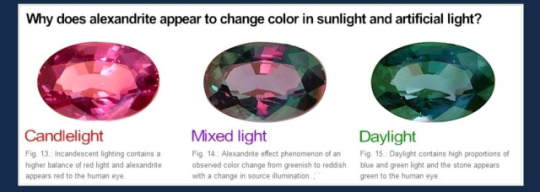
Pleochroism
Pleochroism is something that most minerals have, it is frequently used to help identify minerals in thin sections, however minerals are usually not pleochroic enough for it to be visible to the naked eye! Pleochroism is just a fancy name to describe the change in how light is absorbed based on the angle of the mineral! So if you scroll up to the first image where I showed a lot of crystal shapes, most of them have angles where they are longer and shorter! This will effect the way light travels in the crystal. Tanzanite is a popular mineral that does this.

Photochromism
This is when a mineral will change color (in a reversible way) when exposed to UV light (or sunlight), I am not going to go too into the details of why this is happening because it would require me to read some research papers and I just don't feel like it. The mineral that is best known for this is Hackmanite!
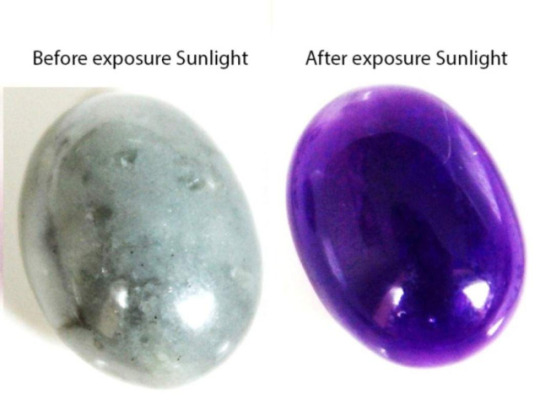
Alright! These are all the really cool color effects that might inspire you or maybe not, but now I am going to talk about how you might find your minerals within a rock!
When I see a lot of magical caves/mines, typically I see them with some variation of a geode honestly, but most minerals are not found like that! Now I am sure most of you guys have seen a geode, so I will not really talk about those, but I will talk briefly about porphyroblasts which is when the mineral grows larger than the minerals around it, this happens in metamorphic minerals!

sorry random stranger, but this is an image of garnets inside a finer-grained rock at gore mountain in New York!
Another way you might find minerals is in a pegmatite! This is when all minerals are really large! This is a formed from really slow crystalizing magma!
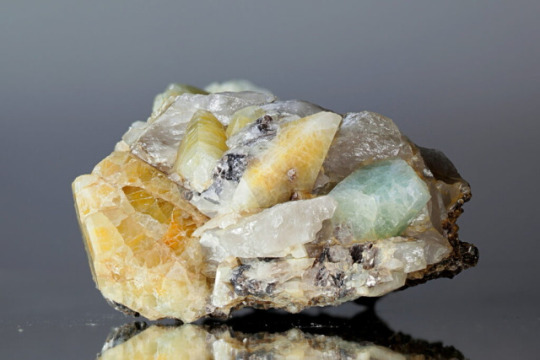
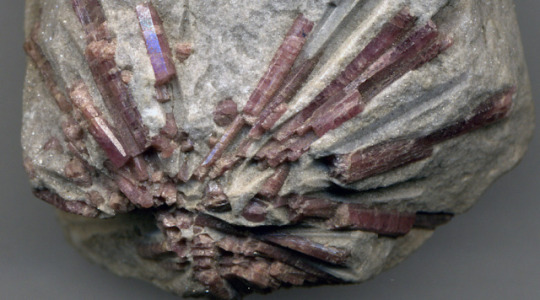
But something else to think about is that your mineral might just be massive, it doesn't have to have distinct crystals, it may be similar to jadeite where small grains grow together which leaves it looking smooth and seamless! A note about all of these is that you would have to mine into the rock to find these, there would not be any natural caves in these rocks! Caves are only ever really formed in limestones and maybe marbles (rocks that react with acid).
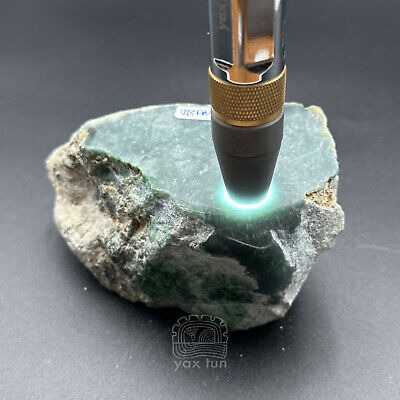
How can your characters identify these minerals?
Typically when you are out in the field you will look to see what type of rocks the minerals are found in (The overall texture of the rock will tell you how it formed). If you know how the rock formed, it will narrow down the amount of minerals you need to think about by quite a bit! Next, you are going to look closely at it and observe its crystal structure, does it have an obvious crystal? if so what is the general shape? If it is broken, how did it break? Did it fracture like glass or did it break along uniform planes. Some minerals have a thing called cleavage (breaks along planes of weakness). If a mineral exhibits this habit, it will again help narrow this down. Next we can look at color. Color can be misleading, because minerals like quartz can be any color imaginable, but minerals like olivine will always be green! The next thing your character can do is test for hardness, minerals all have a specific hardness that can help identify it as well.
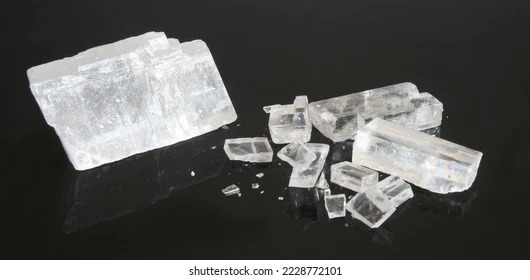
After you go through all of this, your mineral might have some special property! This could be magnetism, fluorescence, reactions to acid, or any of the color changing effects I mentioned above! Other than that, your character can take it back to a lab and do a number of things to identify it, but the most typical thing would be for them to make a thin section (very thin piece of the rock) and observe it under a cross polarized microscope!

On that note folks! I hope this helped in some way in thinking of new magic mineral properties! I have other guides that explore some different fictional worldbuilding issues you might run into, but if you have any topics you would like me to cover please that I haven't mentioned already, let me know!
#geology#rocks#creative writing#fictional world#worldbuilding#dnd#dnd worldbuilding#worldbuilding stuff#writing resources#info post#information#writing
6K notes
·
View notes
Text
Book binding 101: Materials
I’ve decided to do a series of posts on how to book-bind since I talk about it a lot, and I think it’s a really fun process. This post will include various inexpensive alternatives to “professional” supplies, many of which you will have at home. Not everyone can afford a cricut and that’s ok! I will also be listing more expensive materials for people who want to invest a bit more into the craft, but they absolutely are not a must.
This first post will focus on a list of supplies you can use to make books, but will not yet get into the instructional part of it. That will come later!
Anyway…
Bookbinding Materials: Essentials
These are items you need to bind, but many you can find around your house!
Sewing thread: Any thread will work for bookbinding, though waxed threads can help reduce tangles. You can also double up thread as another way to prevent tangling if you so choose. Waxed thread is definitely more expensive, so it can be good to use what you have starting out. Here’s a link to the waxed thread I used for those that are interested. You can buy it in a lot of different colors! (White is good if want an “invisible” thread).
Sewing needle: A lot of people say to use a curved needle for binding, but I’ve never found it to be much different from using a regular needle. If you have one, I would recommend a larger needle, however, since it’s better for piercing through signatures (aka the stacks of pages you bind together). In other words: there’s no special needle you need to bind books.
Ruler: I’d recommend any metal ruler since it’s better to use as a straight edge for cutting. There’s a good chance you already have one. It’s just used for measuring and being a straight edge. Nothing fancy.
Paper: Any paper will work. What you wanna use depends on your project really: if you’re binding together a work of text you’ll want to use some kind of printer paper (of course). If you’re making a sketchbook, you can fold up some sketching paper. I like to get sketchbooks with perforated edges so I can tear them out easily if I want to use a blank page for bookbinding. You can also buy large sheets of paper made for any medium. For example, if you want a sheet of water color paper, just search “large watercolor paper sheet”.
Awl (or all alternative): An awl is a tool used to poke sewing holes. It’s nice because it’s sharp and ergonomic, but you can totally also use a pushpin or even a sewing needle.
Bone folder (or a bone folder alternative): A bone folder creates sharp creases when you fold your pages, making them lay flatter. It also helps define the hinge gap on finished books, making it open easier. You can use a ruler if you don’t have one.
PVA glue: PVA glue is what to look out for when it comes to binding glue. There are some designed specifically for bookbinding, which spread out a bit faster than ones that aren’t. You can also use tacky glue which IS a PVA glue.
Book board: Also sometimes called chip board, Davey board, or mat board. This is what you’ll use for hard cover books. It is important to use book board specially, as cardboard will warp. You can buy book board directly, or you can cut the covers off of old textbooks or binders, unwrap the paper/plastic around the board, and use that!
Box cutter or utility knife: for cutting the board
Decorative paper and book cloth: For wrapping around cover boards and for endpapers. Book cloth can also be used to cover boards. You can also draw your own designs on Bristol paper if you want (or any paper with a similar thickness/durability). When it comes to decorative paper I like to either get scrapbook paper or rolls of fancy handmade paper (you can get those on Etsy, through paper source, or through bookbinding websites).
Bookbinding materials: Optional (and not crazy expensive)
These are supplies that you don’t need for binding but that can make the process easier and/or help with the decorative elements of your books. I’d recommend these things for when you’ve been binding for a while and feel these things could be helpful!
Paper trimmer: can cut a few sheets of paper evenly—I find it really helpful for endpapers
Stencils: Super helpful if you want to add text on the covers
Stamps: Good for adding text and also great for adding illustrations if you’re not able to draw them on your own. You can buy ink pads for them or use markers by coloring over the stamp lightly and using the stamp immediately so it doesn’t dry (I’ve tested this with alcohol markers and it works very well)
Paint markers: great for drawing directly on the cover. Since they’re opaque they can imitate the look of vinyl. You can also get them super painterly if you want. The internet usually talks about poscas but there are tons of different brands. Do some research, figure out what you like & can afford.
Hot foil pen & heat transfer foil: Perfect if you want to add foil to your covers but don’t want to spend a ton of money on a cricut. A lot of binders uses the foil quill brand, but there are ones that cost less and work the same (I have both a cheaper one & an actual foil quill because I wanted some nib variation. As long as the pen has good reviews that aren’t from bots you should be good). Also remember: don’t use foil designed for going through laminators (I.e. decofoil) . It doesn’t work the same way.
Bookbinding Materials—Expensive
These are materials I’d recommend for people who have been bookbinding for a while & feel that it’s something they really want to invest in. To be fully transparent, I’m a college student and don’t own these and have little personal experience with them. However, I know a lot of binders who love them!
Cricut machine—Cricuts are cutting machines that can make precise cuts into paper, wood, bookboard, or vinyl. A lot of binders will cut designs out of vinyl and apply them to the covers using a heat press.
Book press—What it sounds like. The pressure helps the pages lay flat and stay even. That being said you can stack heavy books on top of your projects, it just may not have the same even pressure. I also know some people will DIY these, so if you’re skilled with power tools you can give it a go!
Paper guillotine—like a paper trimmer but bigger and can cut more sheets of paper at once. I believe really good ones can also be used to cut bookboard!
Those are all the materials I can think of! Hope this can work as a good starting point for those interested in the craft. I’ll definitely be posting more info about bookbinding for people who are interested :)
-Zoë💗
#bookbinding#book binding#fan binding#craftblr#information#tutorial#book binding resource#resource#book binding 101
879 notes
·
View notes
Text
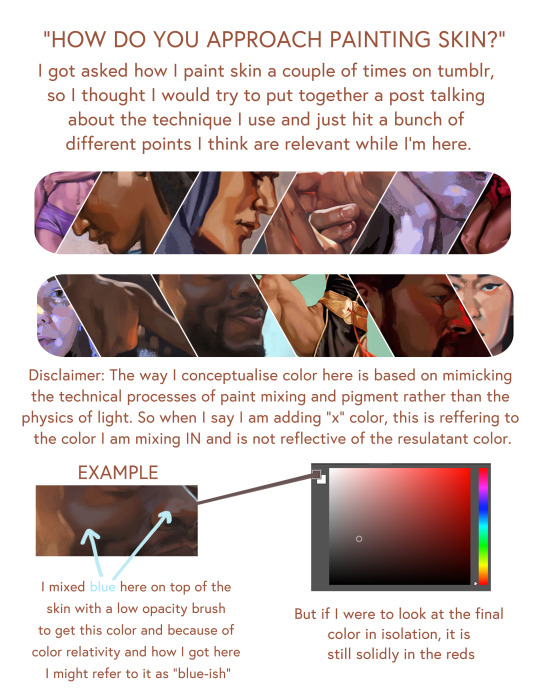
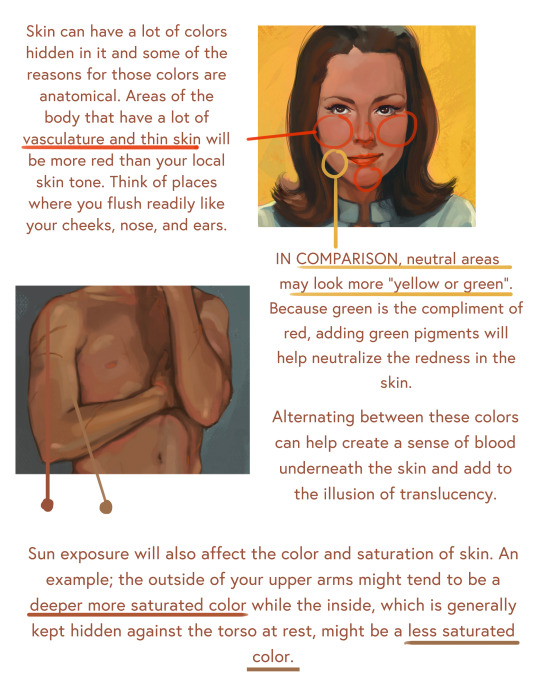
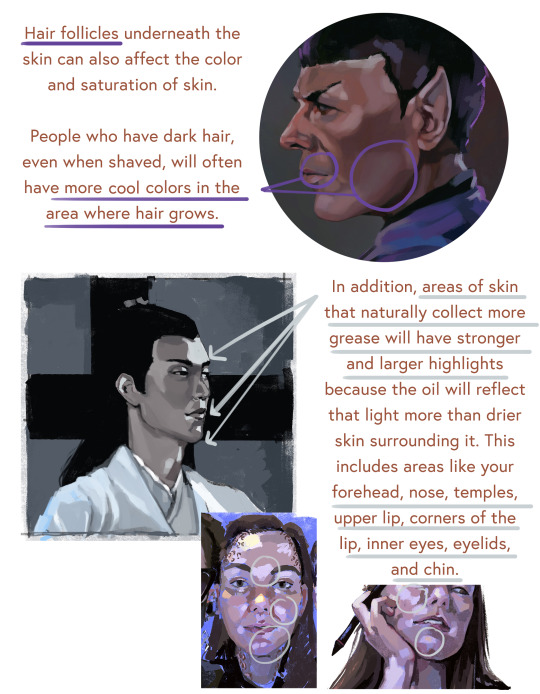
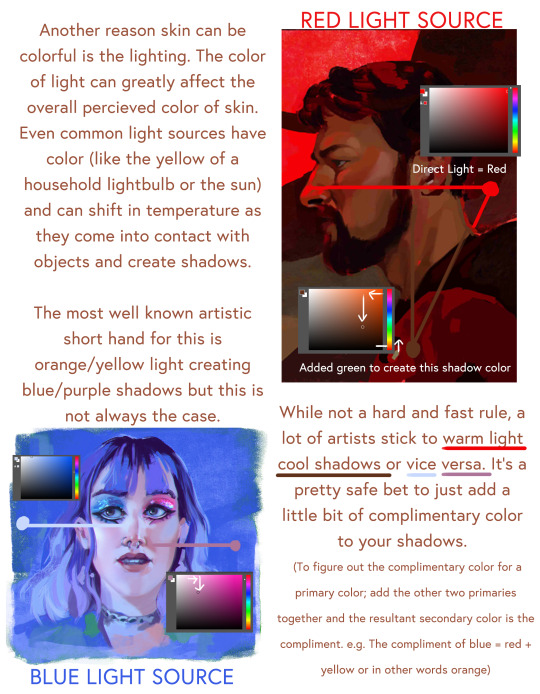
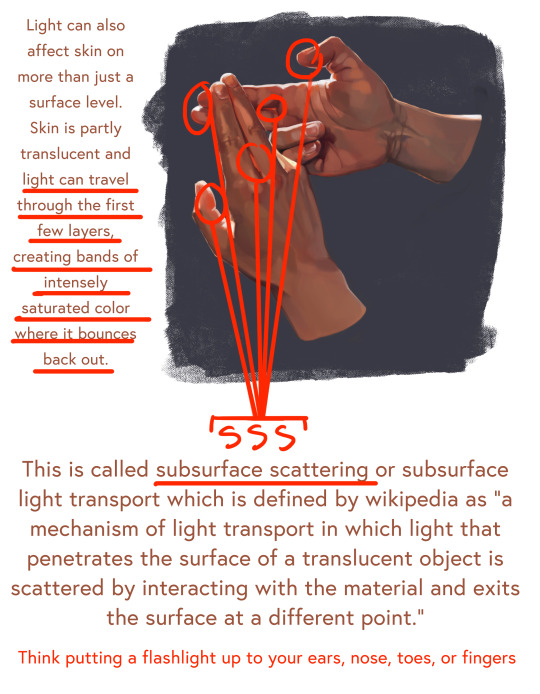
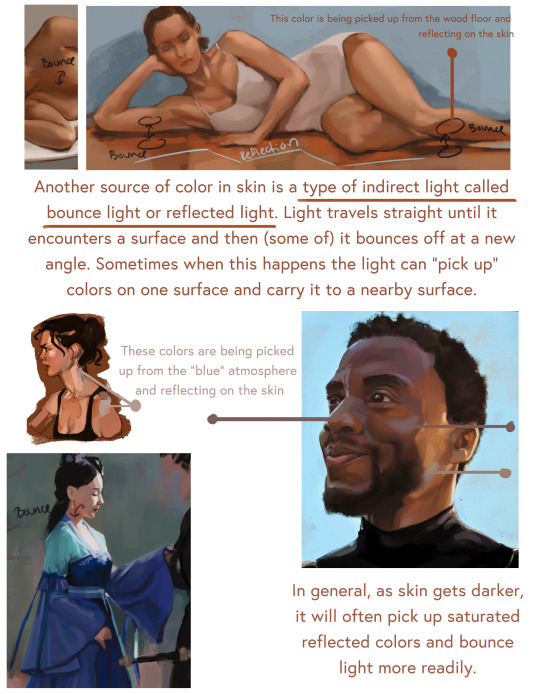
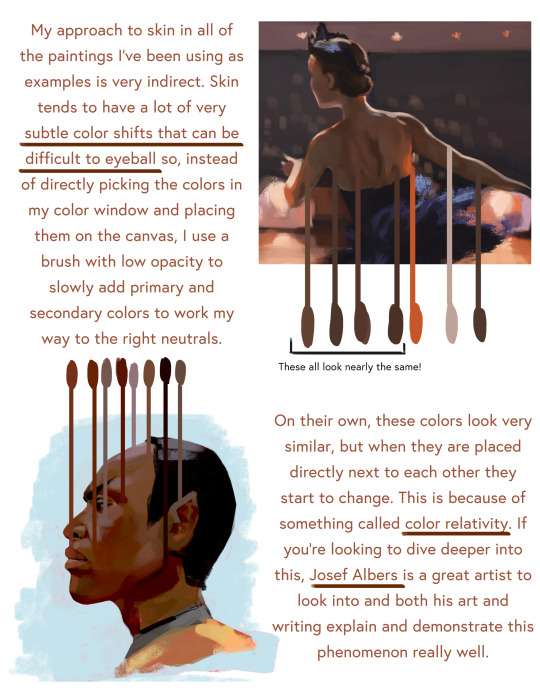
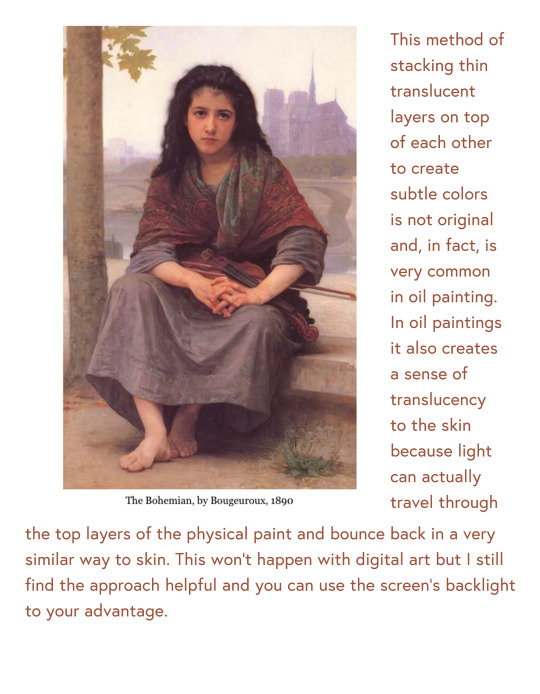
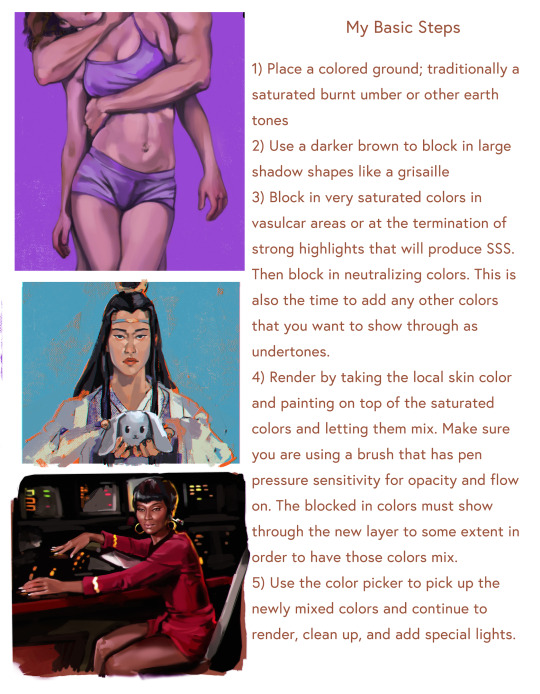
Artist: RaeGunBlast
#raegunblast#art#2d#painting#artists on tumblr#art help#art reference#art resources#art information#art process#how to paint skin#art tutorial#artist#art practice
3K notes
·
View notes
Text
AI DISTURBANCE "OVERLAYS" DO NOT WORK!
To all the artists and folks who want to protect their art against AI mimicry: all the "AI disturbance" overlays that are circulating online lately DON'T WORK!
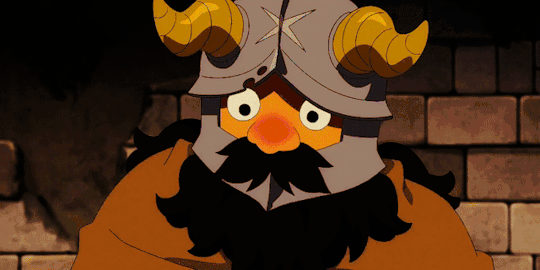
Glaze's disturbance (and now the Ibis Paint premium feature, apparently. Not sure.) modifies the image on a code-level, it's not just an overlayed effect but it actually affects the image's data so AI can't really detect and interpret the code within the image. From the Glaze website:
Can't you just apply some filter, compression, blurring, or add some noise to the image to destroy image cloaks? As counterintuitive as this may be, the high level answer is that no simple tools work to destroy the perturbation of these image cloaks. To make sense of this, it helps to first understand that cloaking does not use high-intensity pixels, or rely on bright patterns to distort the image. It is a precisely computed combination of a number of pixels that do not easily stand out to the human eye, but can produce distortion in the AI's “eye.” In our work, we have performed extensive tests showing how robust cloaking is to things like image compression and distortion/noise/masking injection. Another way to think about this is that the cloak is not some brittle watermark that is either seen or not seen. It is a transformation of the image in a dimension that humans do not perceive, but very much in the dimensions that the deep learning model perceive these images. So transformations that rotate, blur, change resolution, crop, etc, do not affect the cloak, just like the same way those operations would not change your perception of what makes a Van Gogh painting "Van Gogh."
Anyone can request a WebGlaze account for FREE, just send an Email or a DM to the official Glaze Project accounts on X and Instagram, they reply within a few days. Be sure to provide a link to your art acc (anywhere) so they know you're an artist.
Please don't be fooled by those colorful and bright overlays to just download and put on your art: it won't work against AI training. Protect your art with REAL Glaze please 🙏🏻 WebGlaze is SUPER FAST, you upload the artwork and they send it back to you within five minutes, and the effect is barely visible!
Official Glaze Project website | Glaze FAQs | about WebGlaze
#no ai#no ai art#ai disturbance#anti ai#anti ai art#artists#artists on tumblr#artists against ai#glaze#webglaze#ibispaint#noai#artists supporting artists#art information#art resources
740 notes
·
View notes
Text
This week's episode impacted a lot of viewers. For many, it was triggering, bringing up memories of abuse. Alternatively, some people who have never had to deal with abuse and therefore don't understand it, have minimized other's feelings. This post is not to get into discourse, but to spread awareness. I'm adding the hotline for domestic violence in the US, please feel free to add information and resources for your country! Under the cut will be information on understanding and recognizing signs of abuse. I will also add sources for where I got the information.
It's important to remember that abuse comes in many forms, not just physical. Recognize the signs. Take care of yourselves ❤️
US National Domestic Violence Hotline: 800-799-7233 or text BEGIN to 88788
Below are types of abuse, and some signs to look out for. Please note, information had been copied directly from websites (listed below) I've reduced each section to 7-9 bullet points, these are not all the signs. Please visit the websites for more information.
Physical Abuse
Pull your hair or punch, slap, kick, bite, choke, or smother you.
Use weapons against you, including firearms, knives, bats, or mace.
Prevent you from contacting emergency services, including medical attention or law enforcement.
Harm your children or pets.
Drive recklessly or dangerously with you in the car or abandon you in unfamiliar places.
Trapping you in your home or preventing you from leaving.
Throw objects at you.
Emotional Abuse
Calling you names, insulting you, or constantly criticizing you.
Isolating you from family, friends, or other people in your life because it makes someone easier to control.
Monitoring your activities with or without your knowledge.
Gaslighting you by pretending not to understand or refusing to listen to you; questioning your recollection of facts, events, or sources; trivializing your needs or feelings; or denying previous statements or promises.
Threatening you, your children, your family, or your pets.
Damaging your belongings, including throwing objects, punching walls, kicking doors, etc.
Blaming you for their abusive behaviors.
When you have an unresolved argument, your abuser will offer you a gift and expect all to be forgiven and forgotten. They will often be insulted if it is not accepted.
Sexual Abuse
Insult you in sexual ways or call you explicit names.
Force or manipulate you into having sex or performing sexual acts, especially when you’re sick, tired, or physically injured from their abuse.
Strangle you or restrain you during sex without your consent.
Hold you down during sex without your consent.
Hurt you with weapons or objects during sex.
Involve other people in your sexual activities against your will.
Force you to watch or make pornography.
Stalking
Showing up at your home or workplace unannounced or uninvited.
Sending you unwanted texts, messages, letters, emails, or voicemails.
Calling you and hanging up repeatedly or making unwanted phone calls to you, your employer, a professor, or a loved one.
Using social media or technology to track your activities.
Manipulating other people to investigate your life, including using someone else’s social media account to look at your profile or befriending your friends in order to get information about you.
Waiting around at places you spend time.
Damaging your home, car, or other property.
All information above came from this website and this one. Please visit the sites for a full list of types of abuse, and all the signs. More types of abuse include: financial, digital, sexual coercion, reproductive coercion, & spiritual abuse.
Abuse can happen between partners/relatives/siblings/coworkers/friends. Here are signs you may be in an abusive friendship (again, not the full list. Visit the website below for all the signs):
They give you the silent treatment.
Lie about you.
Gaslight you.
Repeatedly dismiss your concerns.
Have double standards for behavior.
Insult you.
Threaten you (physically, or to get you in trouble, or threaten to end friendship).
Never take responsibility.
Isolate you.
Physically hurt you.
more info here
Recognize the signs of child abuse
Bullying at work
sibling violence
Remember, you don't have to check all the boxes to be in an abusive situation. One bullet point is too many.
#btpositivityproject#911 abc#911#bucktommy#<- target audience#tw abuse#another reminder that I am not here to get into discourse#I'm providing information for people that may need it#Please add information and resources for your country/region!
198 notes
·
View notes
Text




Next 2 U by Kehlani 🇵🇸🤍
#she’s been providing resources and information about Palestine since October!!#there are resources and donation links for Palestine / Sudan and Congo in the description of her new vid as well!#kehlani#free palestine
647 notes
·
View notes
Text
FREE MAPS
Today's PSA about resources from the federal government that you might not know about: virtually all of the USGS's maps are in the public domain and free to download. More than a century's worth of them. They even have a nice map-based browser so you can search by location and filter by date, scale, etc. You can also generate your own topo map using the best available data for whatever area you define (within the US) using the topoBuilder application.
You can ALSO get printed versions for quite a low price - I just got one for my office for $9 plus shipping, which came to ~$15 total, I think.


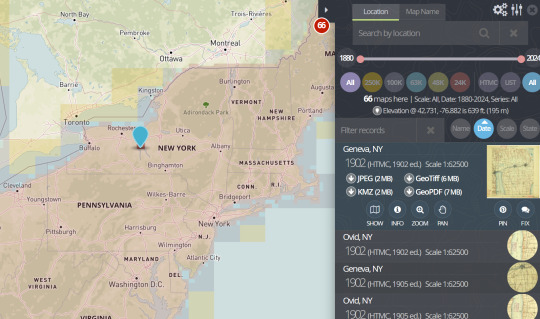
SO if for INSTANCE you wanted a cool old map for your wall and you went to Etsy and found some schmuck selling reprints of old USGS maps for +$50 bucks - THEY'RE SCAMMING YOUUUUUUU they are depriving you of your American right to life, liberty and the pursuit of topographic data
#can you tell i'm mad#maps#cartography#topography#usgs#information#free stuff#get your taxpayer dollars' worth#federal government#federal resources
377 notes
·
View notes
Text
Characters Bios for The Boys in the Boat

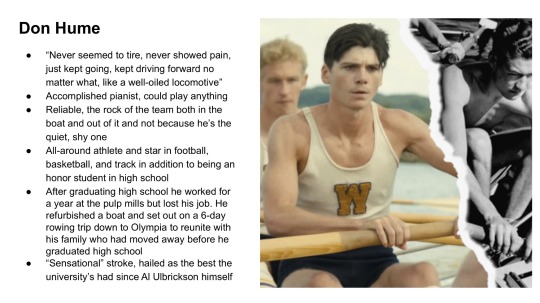

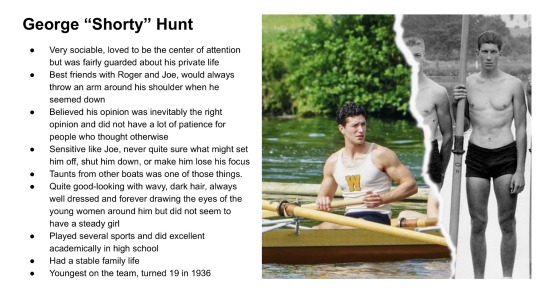
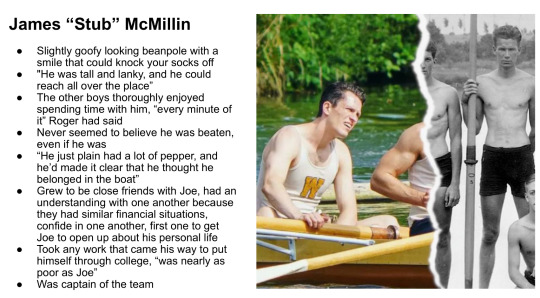




#PLEASE LET ME KNOW IF I GOT ANYTHING WRONG#I WILL GLADLY FIX IT#source was almost entirely the book by Daniel James Brown#bobby moch#the boys in the boat#boys in the boat#character bios#fanfiction references#fic resources#information#references#research#character guide#Don Hume#Johnny white#Joe Rantz#chuck day#roger morris#george shorty hunt#george hunt#Gordy Adam#James stub McMillan
407 notes
·
View notes
Text
Someone created a Master Document for Palestine, the Democratic Republic of Congo (DRC), Sudan, Haiti, Yemen, and Hawai'i full of relevant accounts to follow, legitimate causes to donate to, and information on their current situations. OP also plans to keep this doc updated and include additional countries, so you can check it periodically for new details. This is a great resource to help educate yourself and help share information!
#palestine#gaza#free palestine#democratic republic of the congo#congo#free congo#sudan#free sudan#haiti#free haiti#yemen#free yemen#hawai'i#resources#to read#sharing information is very important but so is educating yourself on these topics
452 notes
·
View notes
Text
Hey guys! As a touchstarved fan, i wanted to talk about Kuras bc i think i just realized something idk 💀💀💀 BUT this is gonna be a long post i just know that.
Before we start, i would like to say i really like Kuras and his design a lot. He is kinda underrated in my eyes and i hope this will change after the game releases bc the moment i saw him, his first cg, i audibly gasped and from that moment i knew that i was going to be obsessed with him. As a turkish guy, my nose looks similar to his, too and it makes me feel better about my insecurity 🤕 ANYWAYS lets get started!
I don't think he treats anyone for free and if i'm not wrong, we know the reason already. As many characters said before, including him, the currency in Eridia is information. When he treats someone, he gains their sympathy. A doctor, treating someone for free... It makes you think, what a good person, you know. He gains the trust of his patients, maybe not Vere's lmao but i stand by what i said. His patients might open up to him as the time goes by and this happens to be a nice source of information or while treating them he can still gather some info. He sees them in their most vulnerable state and makes them think they owe him something, anything worth saying or doing in return.
He also saw MC at their most vulnerable state, unconscious and naked. And I don't think he did anything weird (💀💀💀) but we still don't know what he did to them while they were unconscious. He has a cut on his palm, we can see it in his sprite (the one which his back visible) BUT I'm still not sure if he healed them with the help of his blood or if he did something else. He must have learned a few things about MC anyway, or he will when the time comes.
His treatment was never free. Maybe he is paying the price of something "bad" he did in the past with treating the residents and visitors of Eridia "for free" and while doing that, he also gathers information. His main objective is still an enigma as we don't know many things about him. But don't worry, those days are not far away. Also english is not my first language and that's why i might have had a hard time explaining my thoughts properly but trust, it makes sense in my head 😭😭😭
I don't think he's a bad person by the way, he's probably just morally grey and his long life and life experiences have shaped him into the twisted and complicated man he is now and that's totally fine with me!
Let me know what you think! I could be dead wrong and that's still okay! I'm so excited for this game... See you in another post<3
#touchstarved game#touchstarved kuras#touchstarved theory#ramblings#Bro has a wide range of information resource it is insane
65 notes
·
View notes
Text
The Disability Library
I love books, I love literature, and I love this blog, but it's only been recently that I've really been given the option to explore disabled literature, and I hate that. When I was a kid, all I wanted was to be able to read about characters like me, and now as an adult, all I want is to be able to read a book that takes us seriously.
And so, friends, Romans, countrymen, I present, a special disability and chronic illness booklist, compiled by myself and through the contributions of wonderful members from this site!
As always, if there are any at all that you want me to add, please just say. I'm always looking for more!
Edit 20/10/2023: You can now suggest books using the google form at the bottom!
Updated: 31/08/2023
Articles and Chapters
The Drifting Language of Architectural Accessibility in Victor Hugo's Notre-Dame de Paris, Essaka Joshua, 2012
Early Modern Literature and Disability Studies, Allison P. Hobgood, David Houston Wood, 2017
How Do You Develop Whole Object Relations as an Adult?, Elinor Greenburg, 2019
Making Do with What You Don't Have: Disabled Black Motherhood in Octavia E. Butler's Parable of the Sower and Parable of the Talents, Anna Hinton, 2018
Necropolitics, Achille Mbeme, 2003 OR Necropolitics, Achille Mbeme, 2019
Wasted Lives: Modernity and Its Outcasts, Zygmunt Bauman, 2004
Witchcraft and deformity in early modern English Literature, Scott Eaton, 2020
Books
Fiction:
Misc:
10 Things I Can See From Here, Carrie Mac
A-F:
A Curse So Dark and Lonely, (Series), Brigid Kemmerer
Akata Witch, (Series), Nnedi Okorafor
A Mango-Shaped Space, Wendy Mass
Ancillary Justice, (Series), Ann Leckie
An Unkindness of Ghosts, Rivers Solomon
An Unseen Attraction, (Series), K. J. Charles
A Shot in the Dark, Victoria Lee
A Snicker of Magic, Natalie Lloyd
A Song of Ice and Fire, (series), George R. R. Martin
A Spindle Splintered, (Series), Alix E. Harrow
A Time to Dance, Padma Venkatraman
Bath Haus, P. J. Vernon
Beasts of Prey, (Series), Ayana Gray
The Bedlam Stacks, (Series), Natasha Pulley
Black Bird, Blue Road, Sofiya Pasternack
Black Sun, (Series), Rebecca Roanhorse
Blood Price, (Series), Tanya Huff
Borderline, (Series), Mishell Baker
Breath, Donna Jo Napoli
The Broken Kingdoms, (Series), N.K. Jemisin
Brute, Kim Fielding
Cafe con Lychee, Emery Lee
Carry the Ocean, (Series), Heidi Cullinan
Challenger Deep, Neal Shusterman
Cinder, (Series), Marissa Meyer
Clean, Amy Reed
Connection Error, (Series), Annabeth Albert
Cosima Unfortunate Steals A Star, Laura Noakes
Crazy, Benjamin Lebert
Crooked Kingdom, (Series), Leigh Bardugo
Daniel Cabot Puts Down Roots, (Series), Cat Sebastian
Daniel, Deconstructed, James Ramos
Dead in the Garden, (Series), Dahlia Donovan
Dear Fang, With Love, Rufi Thorpe
Deathless Divide, (Series), Justina Ireland
The Degenerates, J. Albert Mann
The Doctor's Discretion, E.E. Ottoman
Earth Girl, (Series), Janet Edwards
Everyone in This Room Will Someday Be Dead, Emily R. Austin
The Extraordinaries, (Series), T. J. Klune
The Extraordinary Education of Nicholas Benedict, (Series), Trenton Lee Stewart
Fight + Flight, Jules Machias
The Final Girl Support Group, Grady Hendrix
Finding My Voice, (Series), Aoife Dooley
The First Thing About You, Chaz Hayden
Follow My Leader, James B. Garfield
Forever Is Now, Mariama J. Lockington
Fortune Favours the Dead, (Series), Stephen Spotswood
Fresh, Margot Wood
H-0:
Harmony, London Price
Harrow the Ninth, (series), Tamsyn Muir
Hench, (Series), Natalia Zina Walschots
Highly Illogical Behaviour, John Corey Whaley
Honey Girl, Morgan Rogers
How to Become a Planet, Nicole Melleby
How to Bite Your Neighbor and Win a Wager, (Series), D. N. Bryn
How to Sell Your Blood & Fall in Love, (Series), D. N. Bryn
Hunger Pangs: True Love Bites, Joy Demorra
I Am Not Alone, Francisco X. Stork
The Immeasurable Depth of You, Maria Ingrande Mora
In the Ring, Sierra Isley
Into The Drowning Deep, (Series), Mira Grant
Iron Widow, (Series), Xiran Jay Zhao
Izzy at the End of the World, K. A. Reynolds
Jodie's Journey, Colin Thiele
Just by Looking at Him, Ryan O'Connell
Kissing Doorknobs, Terry Spencer Hesser
Lakelore, Anna-Marie McLemore
Learning Curves, (Series), Ceillie Simkiss
Let's Call It a Doomsday, Katie Henry
The Library of the Dead, (Series), TL Huchu
The Lion Hunter, (Series), Elizabeth Wein
Lirael, (Series), Garth Nix
Long Macchiatos and Monsters, Alison Evans
Love from A to Z, (Series), S.K. Ali
Lycanthropy and Other Chronic Illnesses, Kristen O'Neal
Never Let Me Go, Kazuo Ishiguro
The Never Tilting World, (Series), Rin Chupeco
The No-Girlfriend Rule, Christen Randall
Nona the Ninth, (series), Tamsyn Muir
Noor, Nnedi Okorafor
Odder Still, (Series), D. N. Bryn
Once Stolen, (Series), D. N. Bryn
One For All, Lillie Lainoff
On the Edge of Gone, Corinne Duyvis
Origami Striptease, Peggy Munson
Our Bloody Pearl, (Series), D. N. Bryn
Out of My Mind, Sharon M. Draper
P-T:
Parable of the Sower, (Series), Octavia E. Butler
Parable of the Talents, (Series), Octavia E. Butler
Percy Jackson & the Olympians, (series), Rick Riordan
Pomegranate, Helen Elaine Lee
The Prey of Gods, Nicky Drayden
The Pursuit Of..., (Series), Courtney Milan
The Queen's Thief, (Series), Megan Whalen Turner
The Quiet and the Loud, Helena Fox
The Raging Quiet, Sheryl Jordan
The Reanimator's Heart, (Series), Kara Jorgensen
The Remaking of Corbin Wale, Joan Parrish
Roll with It, (Series), Jamie Sumner
Russian Doll, (Series), Cristelle Comby
The Second Mango, (Series), Shira Glassman
Scar of the Bamboo Leaf, Sieni A.M
Shaman, (Series), Noah Gordon
Sick Kids in Love, Hannah Moskowitz
The Silent Boy, Lois Lowry
Six of Crows, (Series) Leigh Bardugo
Sizzle Reel, Carlyn Greenwald
The Spare Man, Mary Robinette Kowal
The Stagsblood Prince, (Series), Gideon E. Wood
Stake Sauce, Arc 1: The Secret Ingredient is Love. No, Really, (Series), RoAnna Sylver
Stars in Your Eyes, Kacen Callender [Expected release: Oct 2023]
The Storm Runner, (Series), J. C. Cervantes
Stronger Still, (Series), D. N. Bryn
Sweetblood, Pete Hautman
Tarnished Are the Stars, Rosiee Thor
The Theft of Sunlight, (Series), Intisar Khanani
Throwaway Girls, Andrea Contos
Top Ten, Katie Cotugno
Torch, Lyn Miller-Lachmann
Treasure, Rebekah Weatherspoon
Turtles All the Way Down, John Green
U-Z:
Unlicensed Delivery, Will Soulsby-McCreath Expected release October 2023
Verona Comics, Jennifer Dugan
Vorkosigan Saga, (Series), Lois McMaster Bujold
We Are the Ants, (Series), Shaun David Hutchinson
The Weight of Our Sky, Hanna Alkaf
Whip, Stir and Serve, Caitlyn Frost and Henry Drake
The Whispering Dark, Kelly Andrew
Wicked Sweet, Chelsea M. Cameron
Wonder, (Series), R. J. Palacio
Wrong to Need You, (Series), Alisha Rai
Ziggy, Stardust and Me, James Brandon
Graphic Novels:
A Quick & Easy Guide to Sex & Disability, (Non-Fiction), A. Andrews
Constellations, Kate Glasheen
Dancing After TEN: a graphic memoir, (memoir) (Non-Fiction), Vivian Chong, Georgia Webber
Everything Is an Emergency: An OCD Story in Words Pictures, (memoir) (Non-Fiction), Jason Adam Katzenstein
Frankie's World: A Graphic Novel, (Series), Aoife Dooley
The Golden Hour, Niki Smith
Nimona, N. D. Stevenson
The Third Person, (memoir) (Non-Fiction), Emma Grove
Magazines and Anthologies:
Artificial Divide, (Anthology), Robert Kingett, Randy Lacey
Beneath Ceaseless Skies #175: Grandmother-nai-Leylit's Cloth of Winds, (Article), R. B. Lemburg
Defying Doomsday, (Anthology), edited by Tsana Dolichva and Holly Kench
Josee, the Tiger and the Fish, (short story) (anthology), Seiko Tanabe
Nothing Without Us, edited by Cait Gordon and Talia C. Johnson
Nothing Without Us Too, edited by Cait Gordon and Talia C. Johnson
Unbroken: 13 Stories Starring Disabled Teens, (Anthology), edited by Marieke Nijkamp
Uncanny #24: Disabled People Destroy Science Fiction, (Anthology), edited by: Elsa Sjunneson-Henry, Dominik Parisien et al.
Uncanny #30: Disabled People Destroy Fantasy, (Anthology), edited by: Nicolette Barischoff, Lisa M. Bradley, Katharine Duckett
We Shall Be Monsters, edited by Derek Newman-Stille
Manga:
Perfect World, (Series), Rie Aruga
The Sky is Blue with a Single Cloud, (Short Stories), Kuniko Tsurita
Non-Fiction:
Academic Ableism: Disability and Higher Education, Jay Timothy Dolmage
A Disability History of the United States, Kim E, Nielsen
The Architecture of Disability: Buildings, Cities, and Landscapes beyond Access, David Gissen
Being Seen: One Deafblind Woman's Fight to End Ableism, Elsa Sjunneson
Black Disability Politics, Sami Schalk
Borderline, Narcissistic, and Schizoid Adaptations: The Pursuit of Love, Admiration, and Safety, Dr. Elinor Greenburg
Brilliant Imperfection: Grappling with Cure, Eli Clare
The Cambridge Companion to Literature and Disability, Barker, Clare and Stuart Murray, editors.
The Capacity Contract: Intellectual Disability and the Question of Citizenship, Stacy Clifford Simplican
Capitalism and Disability, Martha Russel
Care work: Dreaming Disability Justice, Leah Lakshmi Piepzna-Samarasinha
Catatonia, Shutdown and Breakdown in Autism: A Psycho-Ecological Approach, Dr Amitta Shah
The Collected Schizophrenias: Essays, Esme Weijun Wang
Crip Kinship, Shayda Kafai
Crip Up the Kitchen: Tools, Tips and Recipes for the Disabled Cook, Jules Sherred
Culture – Theory – Disability: Encounters between Disability Studies and Cultural Studies, Anne Waldschmidt, Hanjo Berressem, Moritz Ingwersen
Decarcerating Disability: Deinstitutionalization and Prison Abolition, Liat Ben-Moshe
Demystifying Disability: What to Know, What to Say, and How to Be an Ally, Emily Ladau
Dirty River: A Queer Femme of Color Dreaming Her Way Home, Leah Lakshmi Piepzna-Samarasinha
Disability Pride: Dispatches from a Post-ADA World, Ben Mattlin
Disability Visibility: First-Person Stories From the Twenty-First Century, Alice Wong
Disfigured: On Fairy Tales, Disability and Making Space, Amanda Leduc
Every Cripple a Superhero, Christoph Keller
Exile and Pride: Disability, Queerness and Liberation, Eli Clare
Feminist Queer Crip, Alison Kafer
The Future Is Disabled: Prophecies, Love Notes, and Mourning Songs, Leah Lakshmi Piepzna-Samarasinha
Growing Up Disabled in Australia, Carly Findlay
It's Just Nerves: Notes on a Disability, Kelly Davio
The Immortal Life of Henrietta Lacks, Rebecca Skloot
Language Deprivation & Deaf Mental Health, Neil S. Glickman, Wyatte C. Hall
The Minority Body: A Theory of Disability, Elizabeth Barnes
My Body and Other Crumbling Empires: Lessons for Healing in a World That Is Sick, Lyndsey Medford
No Right to Be Idle: The Invention of Disability, 1840s-1930s, Sarah F. Rose
Nothing About Us Without Us: Disability Oppression and Empowerment, James I. Charlton
The Pedagogy of Pathologization Dis/abled Girls of Color in the School-prison Nexus, Subini Ancy Annamma
Physical Disability in British Romantic Literature, Essaka Joshua
QDA: A Queer Disability Anthology, Raymond Luczak, Editor.
The Right to Maim: Debility, Capacity, Disability, Jasbir K. Puar
Sitting Pretty, (memoir), Rebecca Taussig
Sounds Like Home: Growing Up Black & Deaf in the South, Mary Herring Wright
Surviving and Thriving with an Invisible Chronic Illness: How to Stay Sane and Live One Step Ahead of Your Symptoms, Ilana Jacqueline
The Things We Don't Say: An Anthology of Chronic Illness Truths, Julie Morgenlender
Uncanny Bodies: Superhero Comics and Disability, Scott T. Smith, José Alaniz
Uncomfortable Labels: My Life as a Gay Autistic Trans Woman, (memoir), Laura Kate Dale
Unmasking Autism, Devon Price
The War on Disabled People: Capitalism, Welfare and the Making of a Human Catastrophe, Ellen Clifford
We've Got This: Essays by Disabled Parents, Eliza Hull
Year of the Tiger: An Activist's Life, (memoir) (essays) Alice Wong
Picture Books:
A Day With No Words, Tiffany Hammond, Kate Cosgrove-
A Friend for Henry, Jenn Bailey, Mika Song
Ali and the Sea Stars, Ali Stroker, Gillian Reid
All Are Welcome, Alexandra Penfold, Suzanne Kaufman
All the Way to the Top, Annette Bay Pimentel, Jennifer Keelan-Chaffins, Nabi Ali
Can Bears Ski?, Raymond Antrobus, Polly Dunbar
Different -- A Great Thing to Be!, Heather Alvis, Sarah Mensinga
Everyone Belongs, Heather Alvis, Sarah Mensinga
I Talk Like a River, Jordan Scott, Sydney Smith
Jubilee: The First Therapy Horse and an Olympic Dream, K. T. Johnson, Anabella Ortiz
Just Ask!, Sonia Sotomayor, Rafael López
Kami and the Yaks, Andrea Stenn Stryer, Bert Dodson
My Three Best Friends and Me, Zulay, Cari Best, Vanessa Brantley-Newton
Rescue & Jessica: A Life-Changing Friendship, Jessica Kensky, Patrick Downes, Scott Magoon
Sam's Super Seats, Keah Brown, Sharee Miller
Small Knight and the Anxiety Monster, Manka Kasha
We Move Together, Kelly Fritsch, Anne McGuire, Eduardo Trejos
We're Different, We're the Same, and We're All Wonderful!, Bobbi Jane Kates, Joe Mathieu
What Happened to You?, James Catchpole, Karen George
The World Needs More Purple People, Kristen Bell, Benjamin Hart, Daniel Wiseman
You Are Enough: A Book About Inclusion, Margaret O'Hair, Sofia Sanchez, Sofia Cardoso
You Are Loved: A Book About Families, Margaret O'Hair, Sofia Sanchez, Sofia Cardoso
The You Kind of Kind, Nina West, Hayden Evans
Zoom!, Robert Munsch, Michael Martchenko
Plays:
Peeling, Kate O'Reilly
---
With an extra special thank you to @parafoxicalk @craftybookworms @lunod @galaxyaroace @shub-s @trans-axolotl @suspicious-whumping-egg @ya-world-challenge @fictionalgirlsworld @rubyjewelqueen @some-weird-queer-writer @jacensolodjo @cherry-sys @dralthon @thebibliosphere @brynwrites @aj-grimoire @shade-and-sun @ceanothusspinosus @edhelwen1 @waltzofthewifi @spiderleggedhorse @sleepneverheardofher @highladyluck @oftheides @thecouragetobekind @nopoodles @lupadracolis @elusivemellifluence @creativiteaa @moonflowero1 @the-bi-library @chronically-chaotic-cryptid for your absolutely fantastic contributions!
---
Submit a Book:
#disability resources#disability#chronic illness#disability books#books#resources#book list#disability literature#literature#disability representation#disabled characters#information#informative#disability education#disability history#disability rights#please add to this#to be updated#long post
2K notes
·
View notes
Text
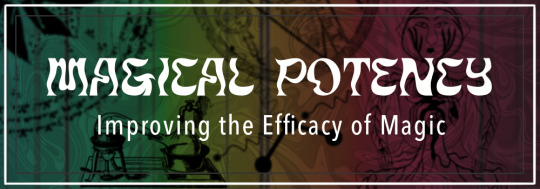
[Title]: Magical Potency: Improving the Efficacy of Magic
Suggested Reading
Finding Balance Threshold Theory Correspondences Conceptualization Vs. Visualization Visualization: Effective Implementation Basics of Energy Work Basics of Spellcasting Spell Logs Intro to Gnosis Bias in Witchcraft The Subtle Body Axioms of Energy Work The Wellsource Energy Work & Spoon Theory Shadow Work: First Steps Intro to Grounding
Introduction
Magical potency refers to the efficacy and strength with which a spell is executed. This encompasses the accuracy with which the ritual is performed, the precision of the elements involved, and the intensity of focus and energy channeled into the endeavor. In simpler terms, it's about increasing the likelihood of a spell's success, assuming all other requisite and advantageous factors are adequately addressed.
The significance of magical potency cannot be overstated. For practitioners, the objective is not merely to perform rituals but to execute them in a way that yields measurable results. In the same manner that a scientist would aim for exactness and reliability in an experiment, a magical practitioner should aim for a high degree of potency in their workings. Achieving this standard is more than a matter of personal pride or skill; it is about the responsible wielding of one's abilities to bring about change. When potency is elevated, the outcomes are more predictable, thereby enhancing the reliability of the magical practice as a whole. Moreover, it minimizes the risk of unintended consequences, which can range from inconsequential to potentially hazardous.
The Magical Potency of a Vast Majority of Publications, From Tumblr to Books
Candle Magic
Candle magic serves as an excellent entry point for neophytes in magical practice. Its allure lies in its straightforward design and uncomplicated mechanics, making it accessible for beginners. However, the simplicity that makes it attractive also serves as its Achilles heel. A plethora of publications, ranging from social media posts to books, frequently omit crucial details that are indispensable for ensuring the spell's effectiveness. For instance, many resources neglect to delve into the nuances of "intent," often misconstrued as mere desire, even though it is actually one's personal truth. Furthermore, these publications have a tendency to reduce the complexity of the practice to mere lists of correspondences, thereby overlooking the intricate mechanics that govern how a spell functions. This dearth of comprehensive information is a disservice to newcomers who seek a robust understanding of the practice, and it impedes their ability to enhance the efficacy of their spells.
Candles & Twine "Cord Cutting"
Another practice that has gained considerable attention is the use of candles and twine for what is commonly referred to as "cord cutting." On the surface, this practice provides valuable insights into personal relationships. However, a closer examination reveals significant shortcomings. Most notably, the ritual fails to fulfill its purported function of severing emotional or psychic connections—what is commonly referred to as "cord cutting." Instead, it remains an exercise in symbolic action that lacks the mechanics necessary to bring about real change. The information provided in popular publications often restricts itself to symbolic associations, failing to offer a comprehensive guide to the mechanics or other vital elements that could make the practice genuinely effective. Consequently, any results are likely psychological in nature, rather than stemming from genuine magical activity, unless utilized as a tool for divination.
Sigil Magic
Sigil magic enjoys widespread popularity due to its accessibility and the relatively common understanding of its mechanics—albeit mainly within the framework of the psychological model. Its versatility is another strong suit, capable of serving as a supplementary element in various other magical practices. However, it's crucial to scrutinize the limitations of this method. The preponderance of popular sigil crafting techniques derives from, or modifies, the Spare method, which operates solely within the psychological model. In essence, this approach amounts to subconscious suggestion rather than authentic magical action. As a result, practitioners may find themselves constrained by a limited scope of magical efficacy. Furthermore, the lack of accessible information on alternative methodologies exacerbates the problem, leaving practitioners with a narrow, and sometimes misleading, understanding of what sigil magic can achieve. The ubiquity of this practice also means that misinformation and misinterpretation are rife, further muddying the waters for those seeking to deepen their understanding and improve their skills.

Increasing the Magical Potency of Common Practices
Candle Magic
To augment the efficacy of candle magic, a considerate approach is essential. First, it's crucial to identify the traditional symbolic associations of various elements involved in the spell and consider whether your own personal correspondences might be more effective. Next, identifying a central point of focus, or state of gnosis, can serve to concentrate your energy more efficiently. This focus should align with your own deeply-held beliefs or personal truths to maximize the spell's efficacy.
Another vital step involves contemplating the specific means by which the spell will manifest its effects. This doesn't merely involve wishing for a particular outcome, but rather planning out the logical steps and mechanisms that will make it happen. This also involves doing conscious energy work that goes beyond mere mental imagery. Instead, one should focus on manipulating energy via the subtle body and energetic senses, perhaps using breath work, gestures, and/or vocalizations as aids.
Identifying the emotional state that will best serve the spell is another significant aspect. This emotional state should be in harmony with your personal truths and can serve to fuel the spell's energy. Additionally, writing out the specific mechanics of how the spell will function can provide clarity and enhance focus during the actual performance. Memorizing all actions or incantations can also prevent disruptions that might break your concentration during the ritual.
Cord Cutting
For those looking to enhance the efficacy of cord-cutting rituals, a complete overhaul is likely required.
Before the working, contemplate the means through which the spell will manifest its effects as to avoid any negative or harmful outcomes. Utilizing twine and a knife—or scissors, for those concerned about safety—can create a strong symbolic action that aids the spell. It's also beneficial to use correspondences, either mental or physical, that are directly connected to the target individuals. This requires either a strong personal knowledge of the individuals involved or a potent taglock to symbolize them.
Conscious energy work is again advisable, and this should be done without relying solely on mental imagery. Maintaining a state of focus, or gnosis, throughout the entire working is essential. To deepen your understanding and improve the potency of the ritual, you might also study various philosophies or religious teachings concerning the concept of fate or destiny.
Identifying an emotional state that aligns with your personal truth can also serve to fuel the energy of the ritual. Once the primary cord-cutting action has been performed, the common chords and candles approach can be employed as a form of divination to gauge the likely effectiveness and manifestation of the spell.
Sigil Magic
For those looking to venture beyond the well-trodden path of the psychological model in sigil magic, a multitude of avenues are worth exploring. To start, one should consider researching or contemplating how sigils could function within different paradigms or frameworks. This might involve developing an entirely new method of sigil crafting that deviates from the commonly used Spare method.
Contemplating the mechanics of how a non-psychological sigil could function is equally important. This might involve studying different cultural practices or philosophies to gain new perspectives. Researching various methods of charging and activating a sigil can also yield valuable insights. Different modalities might be more effective depending on the specific nature of the application in which the sigil will be used.
When incorporating a sigil into another spell, it's crucial to think critically about how the two will interact and complement each other. Drawing the sigil while in a state of deep focus, or gnosis, can enhance its accuracy, If this state is backed by strong emotional energy that aligns with your personal truths, its momentum will increase. The precision of a sigil can also be highly increased by performing energy work consciously while drawing the sigil. Finally, selecting a method of charging and activation that complements both your own capabilities and the specific nature of the working can serve to greatly enhance the overall potency of the spell.

General Practices and Methods to Improve Magical Potency
Research, Study, Experimentation, and Recording
The cornerstone of enhancing magical potency lies in a rigorous approach that involves research, study, experimentation, and detailed recording. When conducting research, it's imperative to look beyond sources that merely resonate with you on a personal level; instead, aim for a diverse array of reputable sources to avoid cognitive bias. Subsequently, study these materials assiduously, revisiting them often to consider ways you might expand or refine the practices described.
The use of experimentation, formulating and documenting predictions about how a spell will manifest is invaluable. These predictions should be dated and revisited to assess the spell's effectiveness. Sharing these predictions with other practitioners can serve as a check against confirmation bias. Conducting low-stakes spells can also serve as a useful methodological testbed, helping you refine your approach based on outcomes.
Maintaining a log of your spells is an essential practice. This archival process will facilitate a retrospective analysis, enabling you to discern which variables contributed to or hindered a spell's effectiveness.
Being Critical
Critical thinking should permeate your magical practice, although it's best applied either before or after a working, not during, so as not to disrupt your focus. Discernment in planning a working can preemptively address potential issues. After the spell's completion, seek feedback from anyone aware of the working but not of its projected outcomes. In your analysis, consider mundane factors that could have influenced the result, recognizing that magical outcomes often manifest through seemingly ordinary means. Keep a record of both successes and failures, and understand that setbacks are educational opportunities, not indicators of personal inadequacy.
Helpful Practices
Regular meditation can serve as a foundational practice for enhancing focus and understanding your inner landscape. Additionally, action flow states can be achieved through rhythmic, lyric-free music coupled with physical activities in sync with the beat. This can facilitate a trance-like state beneficial for magical work. Shadow work, while in no way is necessary, can help you uncover deeply rooted personal truths, while the development of personal symbolic associations can facilitate more potent states of focused awareness.
Energy Work
Contrary to popular misconceptions, energy work is neither a form of mental imagery nor a misapplied concept often referred to as "intent." It involves a nuanced understanding of one's subtle body and its energy centers. Identifying your Wellsource—the origin point of your energy—can further deepen your practice. Mastering the art of manipulating this energy effectively can be a powerful tool in improving magical potency.
Appropriation and Decolonization
It's crucial to recognize the importance of decolonizing one's magical practice. This entails a conscious effort to eschew cultural appropriation and to respect the origins and contexts of various magical systems. While learning from diverse traditions can enrich your practice, it should never involve taking elements out of their cultural context for personal use without proper understanding and initiation. Decolonizing your magical practice is a significant endeavor that requires sustained commitment, self-awareness, and active engagement. Here are some steps to help you in this important journey:
Educate Yourself: The first step in decolonizing your practice is to become knowledgeable about the histories, cultures, and traditions from which various magical practices originate. This will help you understand the contexts in which these practices were developed and how they have been affected by colonization.
Acknowledge Origins: Always give credit to the cultures, traditions, and communities from which certain practices and tools originate. This is not only a matter of respect but also a way to counteract the erasure that often occurs when practices are appropriated.
Assess Your Sources: Evaluate the materials you are using to learn about magical practices. Are they written or produced by individuals from within the tradition? Do they provide historical and cultural context? Are they respectful and do they avoid exoticizing or commodifying the practices they describe?
Reflect on Motivations and Entitlement: Examine your reasons for incorporating specific practices or tools into your own practice. Are you doing it because it's "trendy" or because you feel entitled to pick and choose from other cultures? Such motivations can be indicative of a colonizer mindset.
Avoid Cultural Cherry-Picking: Engaging deeply with another culture's practice means more than just adopting its magical or spiritual elements. It involves an understanding and respect for the culture as a whole, including its history, struggles, and contributions.
Engage in Dialogue: If you are interested in a practice that originates from a culture different from your own, try to engage in a respectful dialogue with individuals who belong to that culture. Seek their perspectives and listen to their experiences, and ask for their insights into ethical engagement with their traditions.
Prioritize Marginalized Voices: Elevate the voices and teachings of individuals from marginalized communities who are sharing their own traditions. Their perspectives are often sidelined but are crucial for a genuine understanding of these practices.
Financial Support: Whenever possible, support practitioners from the culture of interest by paying for their services, buying their products, or donating to causes they recommend. Economic empowerment is a form of reparative justice.
Revise and Reassess Continually: Decolonization is not a one-time action but an ongoing process. Keep updating your practices as you gain more knowledge and understanding. This may mean abandoning practices or tools that you now recognize as inappropriate for you to use.
Be Accountable: If you make a mistake—and most people do when they are learning—own it. Apologize, learn from it, and make amends if possible. Then take steps to ensure you do not repeat the same mistake.
Advocate and Educate: Use your platform, however big or small, to educate others about the importance of decolonizing magical practices. Share resources, engage in conversations, and challenge instances of appropriation you encounter.
Practice Humility: Recognize that the process of decolonization involves continual learning and that you won't have all the answers. Be open to criticism and willing to change your viewpoints and practices accordingly.
How Appropriation Negatively Affects Magical Potency
The act of appropriation in magical practices not only raises ethical concerns but also has deleterious effects on the potency of the rituals involved. One of the most glaring issues arises from the isolation of a practice from its original cultural context. Traditions, rites, and spells often have deeply ingrained cultural meanings and histories. When extracted from their native milieu, these practices lose the richness and nuance that contribute to their efficacy. The symbols, words, and actions employed in a ritual are often deeply tied to the specific geography, language, and folklore of its origin. Stripping away this context can dilute the ritual's power, rendering it a mere simulacrum of its original form.
Another significant concern pertains to the connections with spirits and ancestors that are inherent in many magical systems. These relationships are often built over generations and are rooted in specific cultural narratives, myths, and practices. When one appropriates these systems without a genuine link to the cultural lineage, the connection to these spirits and ancestors becomes tenuous at best. In some cases, this could even be seen as a form of spiritual trespassing, which not only questions the ethical standing of the practitioner but also diminishes the effectiveness of the ritual. These ancestral and spiritual links act as conduits for magical energy, and without them, the practice becomes hollow.
Lastly, the issue of alignment with one's personal truth cannot be ignored. Each individual has a unique set of beliefs, experiences, and perspectives that inform their magical practice. When one adopts practices from another culture without proper understanding or respect, there is a high likelihood that these borrowed elements will not align well with one's personal truths. This dissonance can create an internal discord, which in turn weakens the potency of the magical working. A harmonious alignment with one's core beliefs and experiences often serves as the bedrock upon which effective magical practice is built.

Implementation of the Concepts Discussed
The efficacy of magical practices can be significantly bolstered by adeptly incorporating cognitive techniques related to memory and repetition. One such method involves capitalizing on short-term memory. After assimilating beneficial information, executing a straightforward magical working immediately afterward can aid in embedding the newly acquired knowledge. This rapid recall and application essentially serve as the anchoring of the information more firmly by immediate utilization. This technique leverages the brain's natural propensity for retaining recently processed information and puts it to practical use, thus enhancing the likelihood of a successful magical outcome.
Subconscious memory plays a similarly pivotal role in the refinement of magical practices. The consistent and repeated consumption of relevant information can precipitate a subconscious framework that thereafter influences your methodologies. Over time, this reservoir of deeply ingrained knowledge becomes an almost instinctive guide during magical workings. The more frequently you engage with this material, the more it seeps into your subconscious, ultimately serving as an internal compass that steers your practices toward greater potency. Hence, the diligent study of reputable materials can lay the groundwork for a more effective and nuanced magical practice.
Repetition, both cognitive and practical, stands as another invaluable tool in solidifying one's magical practices. Repetitive engagement with the material, whether it's through written summaries, vocal articulation, or mental rehearsal, can fortify the neural pathways associated with that specific information. Furthermore, the regular enactment of magical workings that incorporate these concepts can engender a form of habituation. These practices, through repetition, become ingrained behaviors, thereby increasing the ease and fluidity with which they can be executed. This habitual nature, in turn, contributes to an overall enhancement of magical potency.

Patreon Shoutouts!

Thank you for your continued support! My patrons help me maintain the drive to create content and help me keep food in my pantry. My patrons of Early Bird tier and higher had access to this article a week before it was public! To see other perks of supporting me, click here!
Thank you for your support:
Megan Kipp!
Cosmicaquamarie
To learn more about me or view my Masterpost, click here.
This post was reviewed and edited for easier reading by ChatGPT.
#witchcraft#beginner witch#energy work#baby witch#witchcraft resources#witchcraft 101#gspell#informational post
204 notes
·
View notes